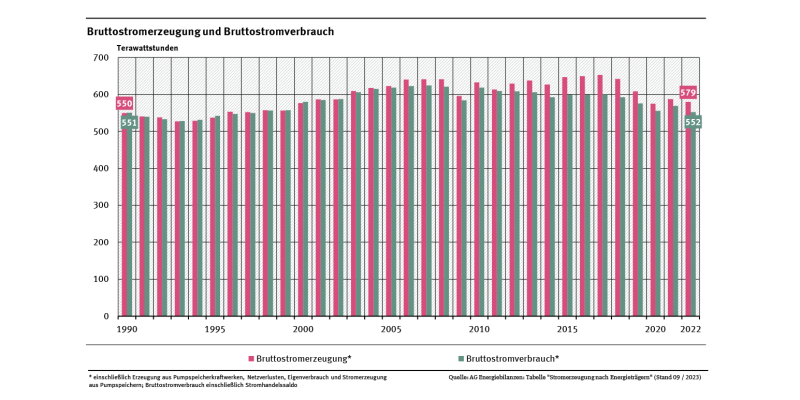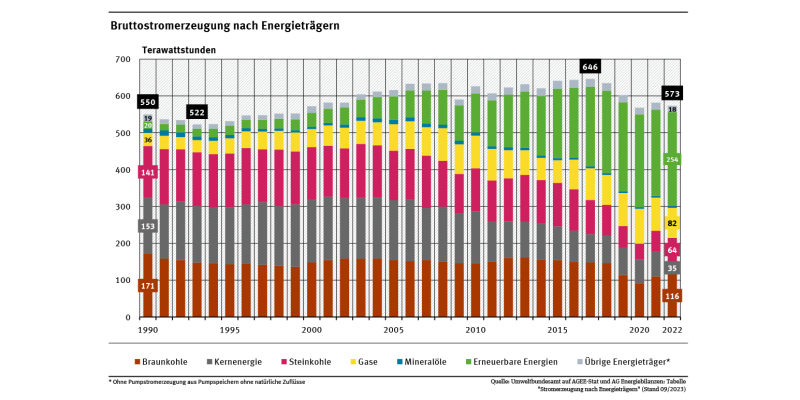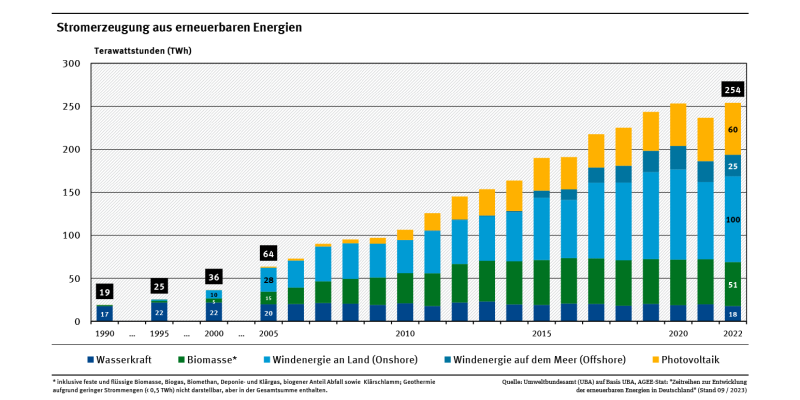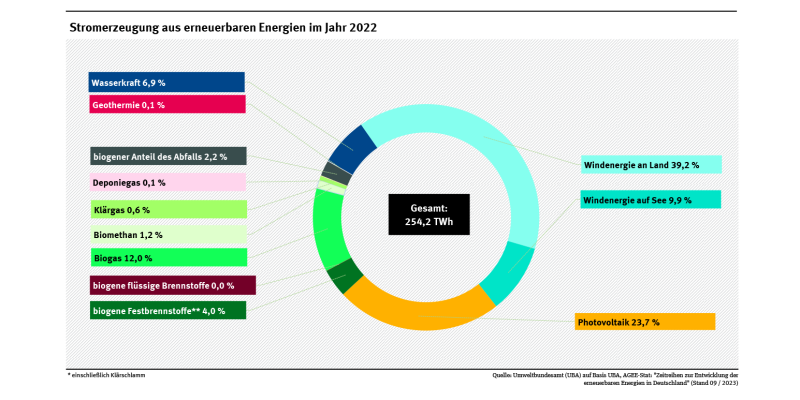Renewable and conventional power generation

 The steadily growing share of renewable energies in gross electricity generation is not offset by a decline in conventional electricity generation to the same extent. Since 2003, more electricity has been produced in Germany than consumed, and thus net electricity has been exported. Renewable energies such as wind, solar and biomass are by far the most important energy source for electricity generation
The steadily growing share of renewable energies in gross electricity generation is not offset by a decline in conventional electricity generation to the same extent. Since 2003, more electricity has been produced in Germany than consumed, and thus net electricity has been exported. Renewable energies such as wind, solar and biomass are by far the most important energy source for electricity generation
Development of gross electricity generation over time
The total amount of electricity produced is calculated as Gross electricity generation denoted. It is measured at the generator terminal before it is fed into the power grid. If you subtract the power plants' own consumption from this value, you get the net electricity generation.
- In the years 1990 to 1993, gross electricity generation decreased as numerous, mostly outdated, industrial and power plants in the new Länder were shut down after German reunification.
- Since 1993, electricity generation has increased again due to growing demand. At the top was the GermanGross electricity consumptionin 2007 it was 624 terawatt hours (billion kilowatt hours). Compared to this level, consumption fell by about 12% by 2022.
- In 2009, there was a significant decline in electricity generation. This was due to the sharp economic slump and the subsequent lower economic output (see Fig. "Gross electricity generation and gross electricity consumption").
- Since 2017, domestic electricity generation has been declining sharply. The reason for this is the decommissioning of conventional power plants and declining electricity consumption. In 2020, the decline in electricity generation due to the Corona pandemic was particularly sharp.
- After a temporary increase in 2021, electricity generation fell significantly again in 2022 and 2023. The main reason was the war in Ukraine and the associated economic recession of the German economy.
Source: Federal Environment Agency on the basis of the Working Group on Energy BalancesDiagram as PDF
Development of electricity exports
Imports and exports in the European electricity network compensate for the differences between electricity consumption and generation. The figure "Gross electricity generation and gross electricity consumption" shows that theGross electricity consumptionhas been lower than production since 2003. Accordingly, Germany has had an export surplus in foreign electricity trade since 2003, reaching a peak of over 52 TWh in 2017. In the following years, net exports declined again and amounted to 27 TWh in 2022. In 2023, electricity imports to Germany increased, so that Germany imported about 11 TWh net.
Gross electricity generation from non-renewable energy sources
The structure of theGross electricity generationhas changed significantly since 1990 (see Fig. "Gross electricity generation by energy source"). The following is a brief presentation of the non-renewable energy sources. Renewable energy sources are described in more detail in the following section.
- The share of lignite, hard coal and nuclear energy in gross electricity generation has fallen sharply. In 2022, all three energy sources together accounted for only 27.0%. In 1990, the figure was still 84.4%.
- The use of hard coal for electricity generation has decreased significantly compared to previous years. The reasons for this were the increasing generation of electricity from natural gas and the increased feed-in of electricity from wind turbines. The costs for CO2emission certificates made operation increasingly uneconomical.
- Electricity generation from lignite has tended to decline since a temporary peak in 2013. For lignite, the increased costs for CO2emission certificates are even more relevant than for hard coal. In 2023, electricity generation from lignite was at its lowest level since 1990.
- The significant decrease in nuclear energy since 2001 has been based on the decision to phase out nuclear energy by the Atomic Energy Act (AtG) of 2002. Electricity generation from nuclear energy is only a fraction of what it was in the early 2000s. In spring 2023, electricity generation from nuclear power was finally discontinued after a final extension of operating times of several months to mitigate the effects of the war in Ukraine.
- Der Anteil von Mineralöl hat sich nur wenig geändert. Er schwankt seit 1990 zwischen 1 % und 2 % der Stromerzeugung.
- Die Stromerzeugung auf Basis von Erdgas lag 2022 etwa 120 % höher als im Jahr 1990, insbesondere durch neue Gaskraftwerke mit Kraft-Wärme-Kopplung. Der Höhepunkt der Erzeugung wurde im Jahr 2020 erreicht (95 TWh). Seitdem ist die Erzeugung auf Basis von Erdgas wieder um etwa 18 % gefallen. Gründe waren die deutlich gestiegenen Gaspreise, insbesondere in Folge des Krieges in der Ukraine.

Quelle: Umweltbundesamt auf Basis Arbeitsgemeinschaft EnergiebilanzenDiagram as PDF
Gross electricity generation based on renewable energy sources
Der Strommenge, die auf Basis erneuerbarer Energien (Wasserkraft, Windenergie, Biomasse, biogener Anteil des Abfalls, Photovoltaik, Geothermie) erzeugt wurde, hat sich in den letzten Jahrzehnten vervielfacht. Im Jahr 2023 machte er erstmals mehr als 50 % der insgesamt erzeugten Strommenge aus. Erneuerbare Energieträger sind also inzwischen die wichtigsten Energieträger für die Stromerzeugung. Diese Entwicklung ist besonders auf die Einführung des Erneuerbare-Energien-Gesetzes (EEG) zurückzuführen (siehe Abb. „Stromerzeugung aus erneuerbaren Energien im Jahr 2023“) und hat ganz wesentlich zum Rückgang der fossilen Gross electricity generation und dem damit verbundenen Ausstoß von Treibhausgasen beigetragen (vgl. Artikel „Erneuerbare Energien – Vermiedene Treibhausgase“).
Die verschiedenen erneuerbaren Energieträger tragen unterschiedlich zum Anstieg der Erneuerbaren Energien bei.
- Die Stromerzeugung aus Wasserkraft war bis etwa zum Jahr 2000 für den größten Anteil der erneuerbaren Stromproduktion verantwortlich. Danach wurde sie von Photovoltaik-, Windkraft- und Biomasseanlagen jedoch deutlich überholt. Im Jahr 2023 wurden auf Basis der Wasserkraft etwa 7 % des erneuerbaren Stroms erzeugt – und 4 % der insgesamt erzeugten Strommenge.
- In den letzten Jahren stieg die Bedeutung der Windenergie am schnellsten: Im Jahr 2023 wurde mehr als die Hälfte des erneuerbaren Stroms und fast 28 % des insgesamt in Deutschland erzeugten Stroms durch Windenergieanlagen an Land und auf See bereitgestellt (siehe Abb. „Stromerzeugung aus erneuerbaren Energien“).
- Bemerkenswert ist zudem die Entwicklung der Stromerzeugung aus Photovoltaik, die im Jahr 2023 22 % des erneuerbaren Stroms beisteuerte und 12 % der gesamten Bruttostromerzeugung ausmachte.
Ausführlicher werden die verschiedenen erneuerbaren Energieträger im Artikel „Erneuerbare Energien in Zahlen“ beschrieben.
-

Electricity generation from renewable energies
Source: Federal Environment Agency based on AGEE-StatDiagram as PDF
Regional differences in the structure of electricity generation
Within Germany, the individual federal states – in accordance with their regional requirements – show significant differences. The map "Power plant capacity in Germany" shows the percentage shares of energy sources (e.g. lignite, natural gas, wind power) in the installed power plant capacity for the individual federal states:
- In the field of renewable energies, the majority of wind energy use is accounted for by the federal states in the northern half of Germany due to the favourable geographical conditions, while the use of photovoltaics and hydropower is dominant in the south of Germany (see in particular the maps "Power plants and wind capacity in Germany" and "Power plants and photovoltaic capacity in Germany").
- The most important domestic fossil fuel is lignite, of which the largest deposits are in the Rhineland and in the area of the new federal states in Central Germany and the Lusatian mining area. All German lignite-fired power plants are spread over these mining areas.
- The German hard coal-fired power plants are highly concentrated in the former hard coalfields on the Ruhr and Saar and, due to cost-effective transport options, an increased spread on heavily frequented inland waterway routes and in coastal regions.
- Electricity generation from nuclear power plants is limited exclusively to the territory of the old federal states.
